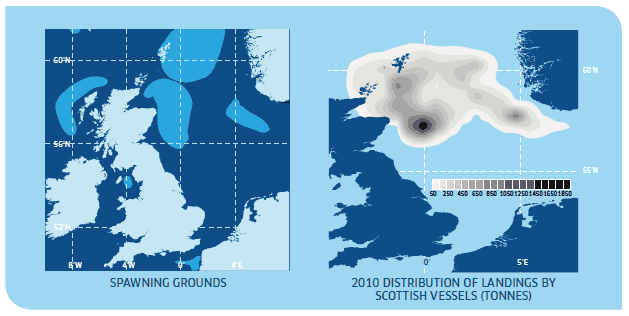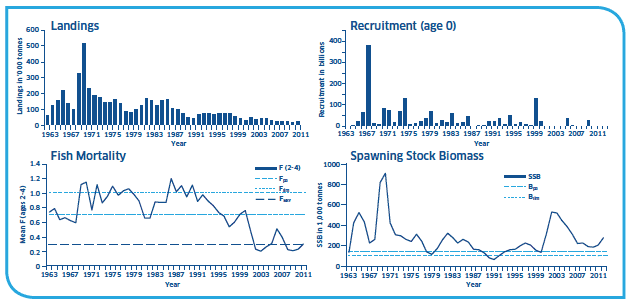Fish and Shellfish Stocks: 2013
Information on the state of fish and shellfish stocks of commercial importance to the Scottish fleet, inclduing Total Allowable Catches (TACs) for each stock.
Haddock Stocks - North Sea (IIIa & IV)
Haddock ( Melanogrammus aeglefinus) is one of the most important fish for Scottish fishermen. With varying abundance throughout the year, it is caught both inshore and offshore by a variety of gears.
2013 position : UK share 29,194 tonnes
Last Year : 25,386 tonnes
Landed into
Scotland in 2011 : 19,021 tonnes
Value for 2011 : £27.3 million
Biology
In the North Sea, haddock occur mainly in the northern and central areas, but can be found as far south as the Humber Estuary. At the beginning of the 20th century they were also abundant in the southern North Sea.
Virtually all three year old fish are mature and in some years over 80% of two year olds may be mature. A three year old female of average size is able to produce around 300,000 eggs in a season. Haddock release their eggs over several weeks. Spawning runs from February until early May and occurs in almost any area of the North Sea, from the Scottish coast to the Norwegian Deeps. There are differences in the length of the spawning season, associated with the size and age of the local population, with age two fish spawning later. The spawning fish on inshore grounds are usually smaller and younger fish than those found in offshore areas. As a result the spawning period of inshore fish can be around half of the time of that found offshore.
In the northern North Sea most of the larvae do not travel far from the Spawning Grounds. Some larvae from the west coast Spawning Grounds can be transported to the North Sea, which they enter through the Fair Isle/Shetland Gap or to the north east of Shetland. Young haddock spend the first few months of life in the upper water layers before moving to the seabed.
Tag recapture studies suggest that whilst adult shoals spread out after spawning, many do not inter-mix with haddock from distant spawning areas. Results from early genetic studies on haddock have suggested there could be different populations within the North Sea. However, whilst there are regional differences in maturity between these proposed populations, tagging, parasite and more recent genetic studies have questioned the proposed differences.
The diet of haddock varies with the size of the fish, the time of year, and with the area. In the winter months haddock of all sizes feed mainly on worms, small molluscs, sea urchins and brittle stars. In the spring and summer fish prey are important, particularly for the larger haddock. The type of fish prey reflects the local availability, with Norway pout being the most common fish eaten in the more northerly areas, whereas sandeels are more important in the central North Sea.

ICES Advice on Management
Information Source: CES advice 2012 ( http://www.ices.dk/sites/pub/Publication%20Reports/Advice/2012/2012/had-34.pdf). Quoted text in italics.

MSY and precautionary approach reference points
| Type | Value | |
|---|---|---|
| Management Plan | F MP | 0.3 |
| SSB MP | 100,000 t | |
| MSY Approach | MSY B trigger | 140,000 t |
| F MSY | 0.3 | |
| Precautionary Approach | B lim | 100,000 t |
| B pa | 140,000 t | |
| F lim | 1.0 | |
| F pa | 0.7 |
State of stock and advice
- Fishing mortality in 2011 is estimated to be 0.3: this means that approximately 26%, by number, of all fish between 2 and 4 years of age were caught.
- Spawning Stock Biomass is estimated to be above both B pa and the MSY B trigger in 2012 at around 272,592 tonnes.
- Fishing mortality and biomass are below and above, respectively, the precautionary limits and the level which is consistent with achieving maximum sustainable yield ( F 20101< F MSY).
- The advice is in accordance with the long-term management plan which recommends human consumption landings in 2013 of 47,811 tonnes for areas IIIa (Skagerrak) and IV.
Adherence to the EU-Norway management plan has contributed to lower fishing mortality levels, increased yield and greatly improved stability of yield.
ICES evaluated the original management plan in 2007 and then the revised plan in 2008 (which allowed for interannual catch variation, or "banking and borrowing" of quota), and concluded that this plan could be accepted as precautionary and could be used as the basis for advice.
The industry's perception is of increasing haddock abundance in all areas of the North Sea in 2011, which is in line with scientific surveys, except for the southern North Sea where research vessel survey data do not show an increase.
In 2013, cod is the limiting species for all the North Sea demersal fisheries. Following the 'cod' scenario (full implementation of the cod management plan), the haddock management plan catch options could not be fully utilized.
Management outcomes for 2013
At the December 2012 Council of Ministers meeting in Brussels, the EU Total Allowable Catch for North Sea (IIIa & IV) haddock was set at 47,811 tonnes, with the UK quota for 2013 at 29,194 tonnes.
This quota decision was in line with the haddock long term management plan agreed between the EU and Norway. Hague preference was invoked which adjusted the final outcome in the UK's favour.
Contact
There is a problem
Thanks for your feedback